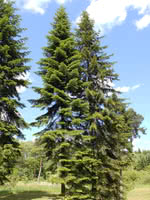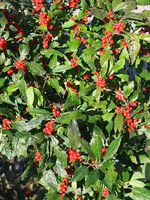Mon-Fri 9am - 5pm Mountain time
Siberian Fir vs Winterberry
Abies sibirica
Ilex verticillata
COMING SOON
(new stock expected: later this season)
CUSTOM GROW
Siberian Fir is an evergreen tree best known for its strong aroma. This tree's needles are popular for essential oils and aromatherapy. It also grows softwood that is used for furniture and wood pulp. This species is very cold hardy and shade tolerant.
This species is bright green and conical shaped. Most interesting is its upright blue cones that fade into brown as they mature.
Winterberry is a small shrub that produces large quantities of bright red berries that remain on the plant through the fall and into the winter. Adding this shrub to your yard will give it a unique splash of color and attract birds, especially after the leaves drop.
Note: although the foliage is attractive on its own, you need at least one male plant near your female plants or they won't produce berries.

